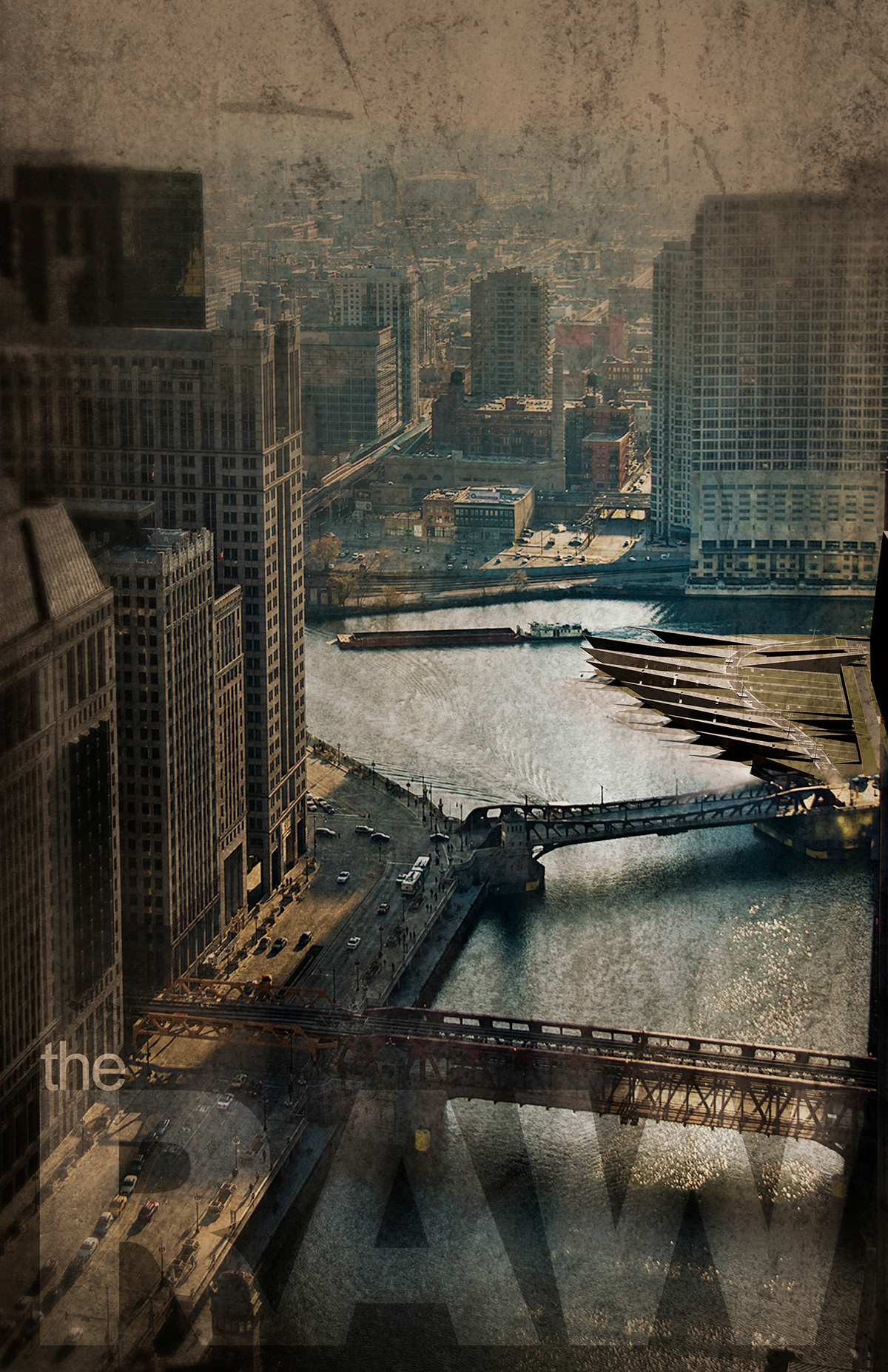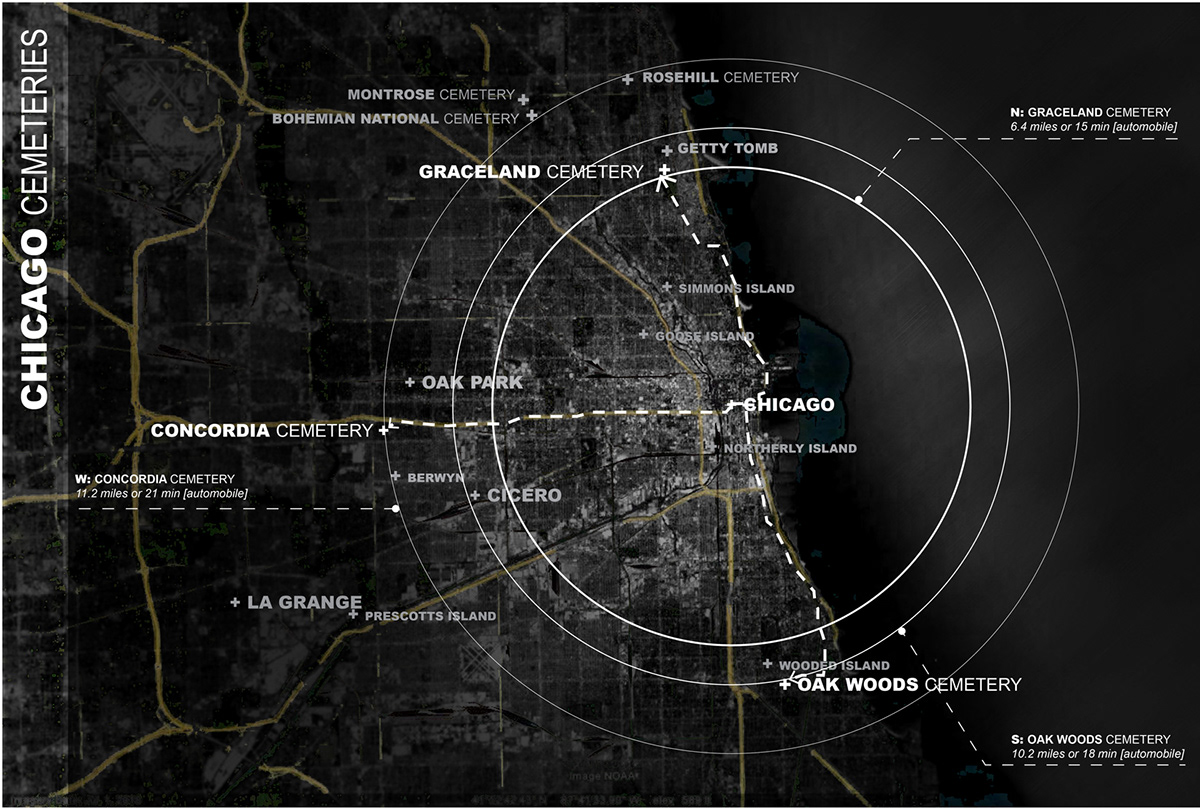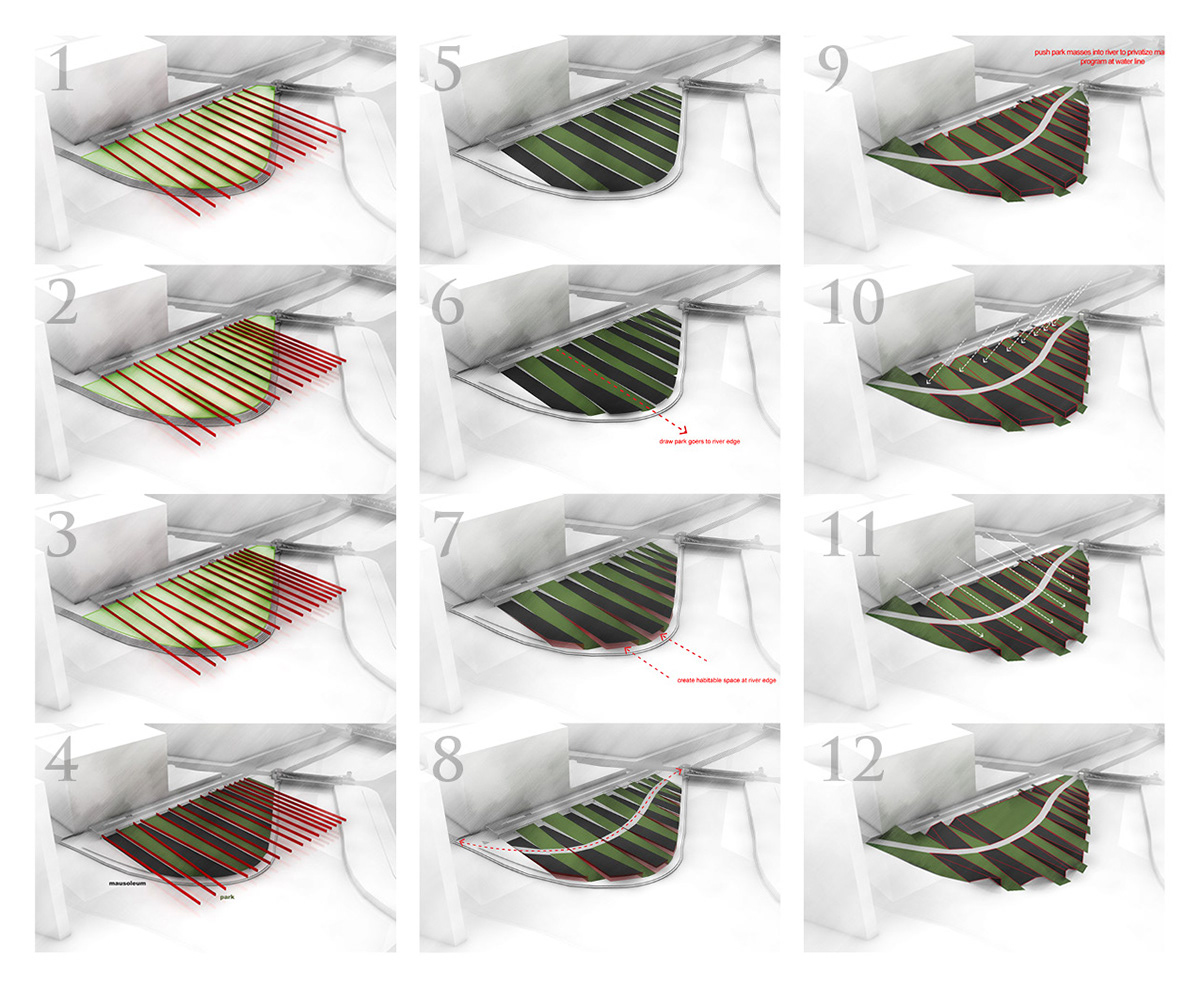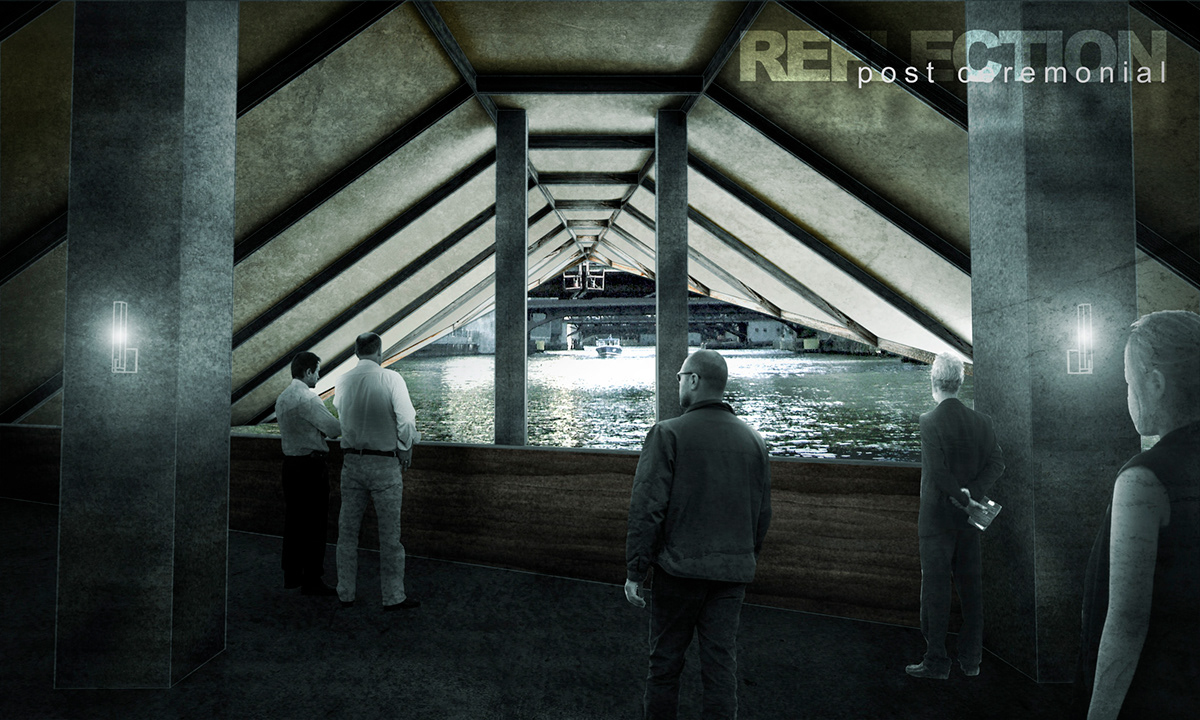the RAW
An Argument for the Expression of Material Degradation and Change in Architecture
When the temporal and material engage in authentic and intentional dialogue we become most aware of change, aging, and death. An awareness of death invigorates our lives with significance, it motivates us to dream about the future, and it offers perspective on our place in the world.

Architecture must embrace the expression of change, aging, and death in its assemblages and in doing so, will not only create places and experiences that engage man in genuine dialogue with his temporal condition, but will create an architecture that sets the stage for the reconciliation of the disparities between man-made environments, the physical world and our imperfect existence.

Image showing a lack of place to house the physical remains of the dead within the heart of the city.

By studying the site at this scale it became quite obvious that while an urban mausoleum dealt with notions of death that the site was informing me to also incorporate notions of life. Or more specifically, the active vitality of the city itself. This map shows the green spaces that surround the Main Branch of the Chicago River. Here, I saw an opportunity to use Wolf Point as a park that would bracket off the green space of this portion of the city and integrate the project into the River Walk.


An experiential stratification of the site exists at Wolf Point where you feel as though you are resting layers beneath the hustle and bustle of the city above. Here, the sounds of the city are filtered or reduced, yet you somehow feel connected to this place. The opressive feeling of this concrete jungle is still felt, but the connection with vegetation and flowing water mitigates its intensity.
The layers of activity and experience felt on the site I related to the layers of earth and soil in which we bury our dead. By placing the mausoleum at Wolf Point, I was able to draw symmetry between the physically entombed and the clients, who after experiencing a loss, would visit this place throughout their lives.
Finally, an opportunity to bring life to the site was discovered linking the architecture with the River Walkl. Now the project at Wolf Point could be thought of as an endpoint to bracket off the main branch of the Chicago River.
The layers of activity and experience felt on the site I related to the layers of earth and soil in which we bury our dead. By placing the mausoleum at Wolf Point, I was able to draw symmetry between the physically entombed and the clients, who after experiencing a loss, would visit this place throughout their lives.
Finally, an opportunity to bring life to the site was discovered linking the architecture with the River Walkl. Now the project at Wolf Point could be thought of as an endpoint to bracket off the main branch of the Chicago River.

When trying to bring together the program of a park and mausoleum at Wolf Point it was important to attempt to seamlessly bring these two programs together; to blur the lines between each while maintaining their identities. The formal driver for this was hands folded in prayer. This strategy gave me the ability to keep each hand(programs) identity while stitching them together in a useful way.
From my thesis research I created a connection between the park program and a changing material that expresses growth. Similarly, the program of the mausoleum was related to a changing material that expresses decay or deterioration. This relationship would prove vital to breathe the ideas of the thesis into the opportunities encountered through the design process.
From my thesis research I created a connection between the park program and a changing material that expresses growth. Similarly, the program of the mausoleum was related to a changing material that expresses decay or deterioration. This relationship would prove vital to breathe the ideas of the thesis into the opportunities encountered through the design process.

1. EXTRUDE EXISTING STRUCTURE
2. REORGANIZE BANDS TO MITIGATE TRAFFIC INTENSITY
3. SKEW BAND AT CONFLUENCE FORMAUSOLEUM
4. INSERT PROGRAMS
5. REMOVE BANDS LEAVING GENERATED FORMS
6. ANGLE PARK FORMS TOWARD THE WATER EDGE
7. ANGLE FORMS TO CREATE HABITABLE SPACE FOR THE MAUSOLEUM
8. INTRODUCE MAIN CIRCULATION PATH
9. SOLIDITY FORMS
10. CARVE PARK FORMS TO GATHERING GROWING LIGHT
11. CARVE MAUSOLEUM FORMS TO GATHER DYING LIGHT
12. FLATTEN SERRATIONS TO CREATE HABITABLE PARK SPACE
2. REORGANIZE BANDS TO MITIGATE TRAFFIC INTENSITY
3. SKEW BAND AT CONFLUENCE FORMAUSOLEUM
4. INSERT PROGRAMS
5. REMOVE BANDS LEAVING GENERATED FORMS
6. ANGLE PARK FORMS TOWARD THE WATER EDGE
7. ANGLE FORMS TO CREATE HABITABLE SPACE FOR THE MAUSOLEUM
8. INTRODUCE MAIN CIRCULATION PATH
9. SOLIDITY FORMS
10. CARVE PARK FORMS TO GATHERING GROWING LIGHT
11. CARVE MAUSOLEUM FORMS TO GATHER DYING LIGHT
12. FLATTEN SERRATIONS TO CREATE HABITABLE PARK SPACE







The plan provides spaces for the Mourner and Endurer. The smallest spaces around the periphery are included as private tombs for the deep level of introversion the mourner experiences.
The large central locations within each pair of tombs became a sunken garden that would contextualize the Endurer inside the mausoleum, but allow the penetration of sounds and smells from the park above.

Above the mausoleum below the active green space of the park is used primarily by the Frequenter.

The mourner’s tombs and the endurer’s sunken garden spaces are contextualized by the active vitality of the park space designed with the Frequenter in mind. In the section below we can see the relationship between the entirety of the park and the mausolem held below. This relationship is one of controlled connection where the Mourner and Endurer’s spaces are primarily separated from the normative activities of the Frequenters above.

The mourners find solitude in the tombs located beneath the surface of the park above. Massive rammed earth walls divide the series of tombs between the Chicago Sun Times building and the Chicago River. Inside, the mourner is given complete privacy from the city and allowed to grapple with the immense struggle and loss associated with death.

The endurer’s sunken garden mirrors the buried feeling of the mourners tombs. But, differing slightly in its relationship to the park, the sunken garden begins to open itself up to the sounds and experiences of the city above through the implementation of a diaphanous cor-ten roof design that allows light and water to fall into the archiecture from the sky above.


Inside the Ceremonial Chamber the mourners and endurers gather to say their final goodbyes before the physical remains are entombed forever. Loved ones gather from across the city on this solemn day to witness a formal ceremony to aid in alleviating the pain of those lost.
A honed and slightly reflective concrete floor draws a link between itself and the river outside. Rustic stone benches remind the denizens of the hard realities of what it means to experience human passing. A quiet light baths the aged oak wood that adorns the walls. The wood fills the space with smells of a carpenter’s shop or an old wooden chest. The focal point of the room is the wall behind the podium where a cooroding cor-ten steel is perforated by a single cross of translucent glass mimicing the crossing of the interfacing forms of the raw. Finally, small slits of light break through the translucent glass above head allowing the light of the sun to perforate the hood while blocking the views of the sky and large skyscrapers.
Within this space the sound of falling tears, subtle sniffles, and muted sobs fill the air.
A honed and slightly reflective concrete floor draws a link between itself and the river outside. Rustic stone benches remind the denizens of the hard realities of what it means to experience human passing. A quiet light baths the aged oak wood that adorns the walls. The wood fills the space with smells of a carpenter’s shop or an old wooden chest. The focal point of the room is the wall behind the podium where a cooroding cor-ten steel is perforated by a single cross of translucent glass mimicing the crossing of the interfacing forms of the raw. Finally, small slits of light break through the translucent glass above head allowing the light of the sun to perforate the hood while blocking the views of the sky and large skyscrapers.
Within this space the sound of falling tears, subtle sniffles, and muted sobs fill the air.

At the conclusion of the ceremony the mourners and gathered loved ones are asked to gather underneath a twenty foot ceiling to chat or discuss the passing of their loved one or friend in an informal setting.
Here, the cor-ten ceiling continues out over the ceremonial chamber and out over the flowing water at the confluence of the Chicago River. Supporting the vast hood are large glulam beams supported by board form concrete columns. The repetition of the columns breaks free of the site boundary and pushes out into the water. As you informally talk with close family and friends you are given a private view of the river separated from the cacophony of pedestrians, horn honking motorists, and the clatter of the elevated train. In this place, you feel protected from the city and are allowed to slow down and experience the passing of the water just above your knee height.
Here, the cor-ten ceiling continues out over the ceremonial chamber and out over the flowing water at the confluence of the Chicago River. Supporting the vast hood are large glulam beams supported by board form concrete columns. The repetition of the columns breaks free of the site boundary and pushes out into the water. As you informally talk with close family and friends you are given a private view of the river separated from the cacophony of pedestrians, horn honking motorists, and the clatter of the elevated train. In this place, you feel protected from the city and are allowed to slow down and experience the passing of the water just above your knee height.

Upon leaving the post ceremonial space it is time to move your loved on into their final resting place. On your way from the ceremonial chamber to the tomb you encounter a sunken garden. Here, the sounds of the park space above filter in through a diaphanous cor-ten roof. The light from the sun filters through the cor-ten and casts onto a lush green garden. The smell of nature fills this space and you can witness small bugs flying by moving toward the light at the ceiling. Surrounding the sunken garden is a continuous bench space and you stop for a second to sit and experience this hidden treasure.
The floor continues the same reflective concrete you traversed in the ceremonial and post ceremonial chambers, but the walls here are quite different. Heavy three feet thick rammed earth walls surround this sunken garden filling the air with an earthy smell that makes you feel as if you have been buried yourself. Across the ceiling above the sunken garden you notice the same aged oak wood from the ceremonial chamber covering the geometry of the roof just above head.
The floor continues the same reflective concrete you traversed in the ceremonial and post ceremonial chambers, but the walls here are quite different. Heavy three feet thick rammed earth walls surround this sunken garden filling the air with an earthy smell that makes you feel as if you have been buried yourself. Across the ceiling above the sunken garden you notice the same aged oak wood from the ceremonial chamber covering the geometry of the roof just above head.

Finally, after passing through the sunken garden space you arrive at the mourner’s tombs. Here, loved ones of the deceased gather to say their final goodbys and watch as their loved one is placed in their eternal resting place. The rammed earth walls you experienced in the sunken garden are even more prevalent here and the feeling of being buried is more pronounced. Perforating the cor-ten hood above is a large four foot translucent glass band. Through the glass you can subtley make out the passing clouds of the city above. The cor-ten steel from the wall in the cermonial space and the sunken garden is continued here in the tombs. Adorning the surface of the tombs themselves the cor-ten draws connection between a decaying materiality and the dead bodies behind the surface.

The roof of the mausoleum is covered with the graass and trees of the park. Here, the sounds of the city are prevalent, but you are somehow one step removed from the intensity of the city. Frequenters gather here to experience the city in a more natural condition. The sound of the wind rustles the trees and shakes the blades of grass as children play and families visit. A series of decaying cor-ten hoods emerge from the green blades of grass that cover the park. As you walk along the main circulation path of the park you encounter the opposite side of the diaphanous cor-ten roof, which covers the sunken garden below. Here, you are reminded that while your jubilant experience of the park represents vitality and life, there is a harsher reality of life buried just beneath the surface.

Finally, as you leave the urban mausoleum you understand the vast difference that exists between the infastructure of the city and the architecture you just experienced. The relationship between decay and growth comes full circle and you contemplate the modes of existence in its most profound sense.
The shimmering reflection of the cor-ten hoods shakes and waves as the blue water of the Chicago River passes by underneath. You look into the dark black shadows underneath the vast projected hoods and remember the profound sadness you felt within.
The shimmering reflection of the cor-ten hoods shakes and waves as the blue water of the Chicago River passes by underneath. You look into the dark black shadows underneath the vast projected hoods and remember the profound sadness you felt within.







